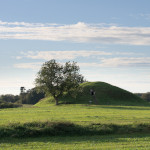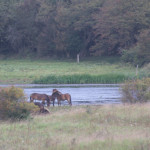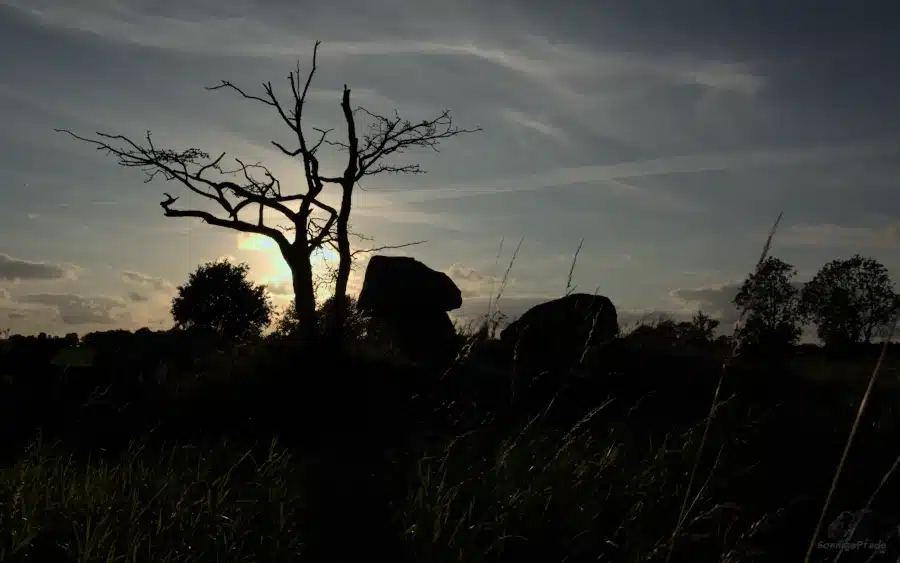
In many areas of Denmark, burial sites from the Stone Age have been preserved in the form of dolmens and burial mounds. One of the most important collections of these megalithic architectural monuments is located near Lindeskov in the east of the island of Funen. Anyone traveling in this region should plan time for a visit to Lindeskov Dolmen and Lykkesholm Manor.
Lindeskov and the prehistoric monuments at Lykkesholm
The Ørbæk å valley stretches from Holckenhavn Fjord on the east coast of Funen to the Ringe area. The small settlement of Lindeskov is located where Lake Gammelmølle and Lykkesholm Castle border the stream. Lindeskov is best known for its collection of burial mounds, dolmens and dolmen chambers from the Stone Age. But if you spend some time here in the valley of Ørbæk å, you can make other historical discoveries and experience beautiful nature.
The long dolmen at Lindeskov
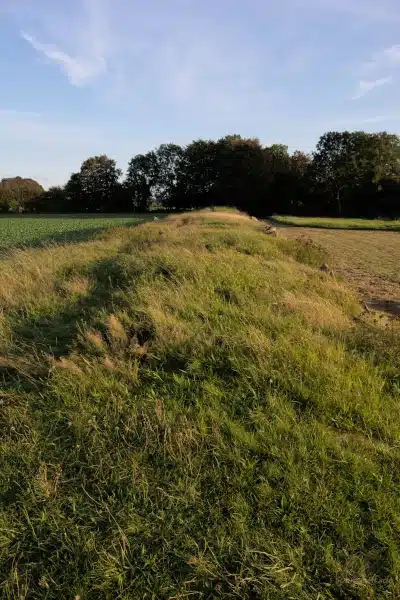
The best known, at least among history buffs and antiquity scholars, is the Langdolmen about 300m north of Lindeskov. At 168m, it is the longest long dolmen (Danish: Langdysse) in the whole of Denmark. With a width of ten meters and a maximum height of around 1.30m, the Lindeskov dolmen lies in the landscape like a flat loaf of bread. The burial mound is framed by a stone setting. Almost all of the 126 kerbstones are still intact. This is quite astonishing, as the dolmens at Lindeskov were erected around 3500 years before Christ. Imagine that – these archaeological monuments are currently 5500 years old! The long dolmen at Lindeskov has only one visible burial chamber.
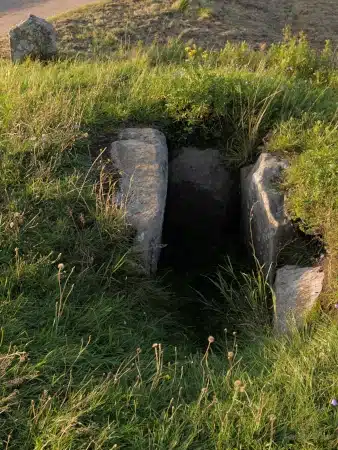
The dolmens in Hestehave Forest
If you walk north along the path from Lindeskov Dolmen for about 500 meters and then take a path to the left into the forest, you will come to more dolmens. The forest is called Hestehave. There is a whole field here with two long dolmens, a round dolmen and a dolmen chamber, which are similar in age to the Lindeskov long dolmen. During excavations in the last century, various grave goods were found in one of the dolmens: a clay vessel, two flint blades and some amber beads.
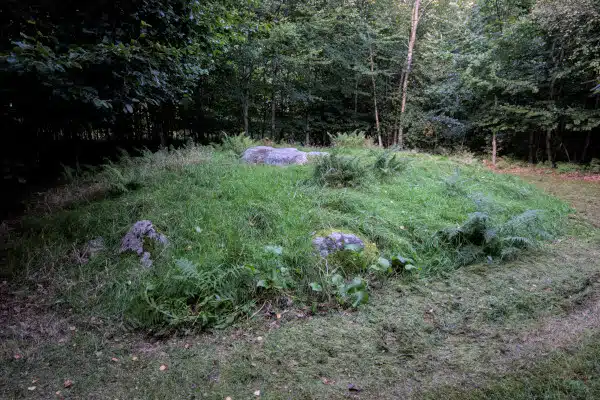
It is known that the burial mound was once again used as a burial site around 1100 years before Christ, i.e. in the late Bronze Age. At this time, cremation was used: The corpse was placed on a pyre and burned. Ashes and bone remains were placed in an earthen vessel, sometimes also in a bronze cup, and this urn was buried. The burial mound was closed and raised if necessary. During archaeological investigations, razors and tweezers as well as a few needles and a knife were found as grave goods from this period.
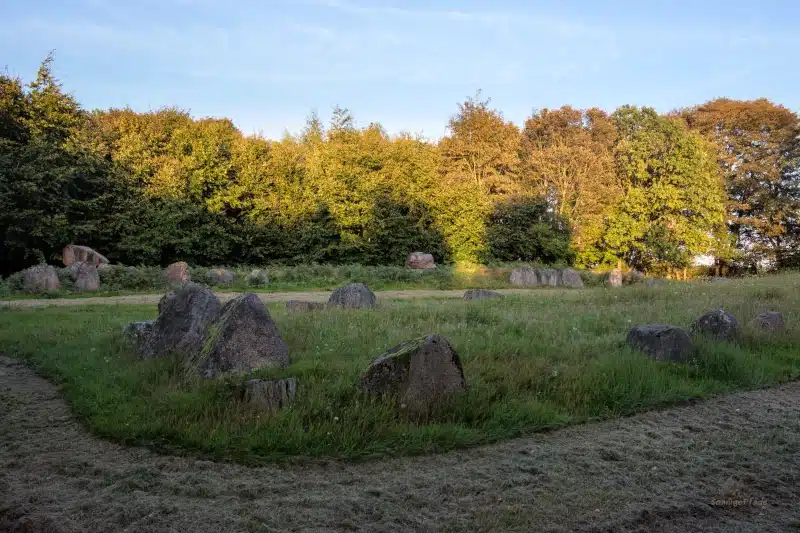
The Assensvej Dolmen
I found the dolmen on Assensvej, directly on the road from Ørbæk to Ellested, particularly impressive. Of course, this had to do with the favorable lighting conditions in the evening as the sun set and dusk began to fall, which bathed the burial mound in a warm orange-golden light. But I was also impressed by the stone settings: this dolmen has 5 burial chambers, which can be clearly recognized by the „stone portals“ on the mound. A permanent monument to megalithic architecture from 5000 years ago!
There is even a „building party theory“ about the construction of the megalithic tombs. It is assumed that groups of workers were on the move in the regions, erecting such stone structures with at least one very knowledgeable master builder. Even if the material consisted mostly of boulders that were not worked, it was still a challenge to move and erect the stones, which often weighed several tons, and to lay them on top of each other in a structurally safe manner. In addition to manpower, this required clever technology and a great deal of experience.
Today, differences in construction methods are used to deduce the migration routes of individual master builders or Stone Age „technology transfer“. The megalithic dolmens at Lindeskov may not be as impressive as the Mårhøj burial mound north of Kerteminde, where you can even crawl through a narrow passage into the burial chamber, but the density, variety and size of the long dolmen make them well worth a stop.
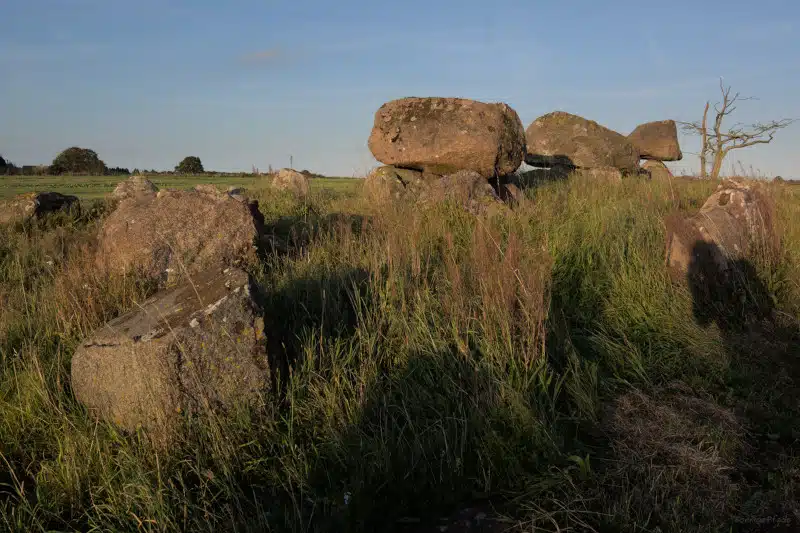
There are other dolmens in the vicinity of Lindeskov, but they are often less well preserved and are usually located on private land, so access is unfortunately not possible.
Recent history in the valley of Ørbæk å
Magelund Voldsted rampart
If you look around carefully or can quickly grasp the location, you will recognize the Magelund Voldsted ramparts south of the road from Assensvej. However, access is via Magelundvej, which connects Lindeskov with Lykkesholm and runs along the Ørbæk å valley. This is also much nicer 🙂

Magelund Voldsted is the remains of a castle from the 13th century. Today, only the 15m high ramparts remain, which rise above a side valley of Ørbæk å. A small stream, the Gammelbæk, flows between wet meadows. However, the castle is said to have originally been surrounded on three sides by water, i.e. real ditches or ponds. First mentioned in writing in 1329, the castle became embroiled in disputes between the Danish nobility, the crown and the Holstein counts. In the 14th century, the Danish king Valdemar was able to push back the Holsteiners and consolidate his power against the nobility. His daughter Margrethe followed this policy and acquired the castle in 1391. At this time, many castles belonging to the nobility were razed – i.e. destroyed – and only castles belonging to those loyal to the king were preserved. Queen Margrethe enfeoffed Magelund Voldsted to her retainer Henneke Olufsøn Bjørn.
Magelund Voldsted Castle included a manor with rich estates in the surrounding area. The castle itself was abandoned at the beginning of the 15th century and replaced by a new settlement in Lykkesholm Castle about 1 km to the west, directly on the course of the Ørbæk å. The use of water power probably played an important role in this.
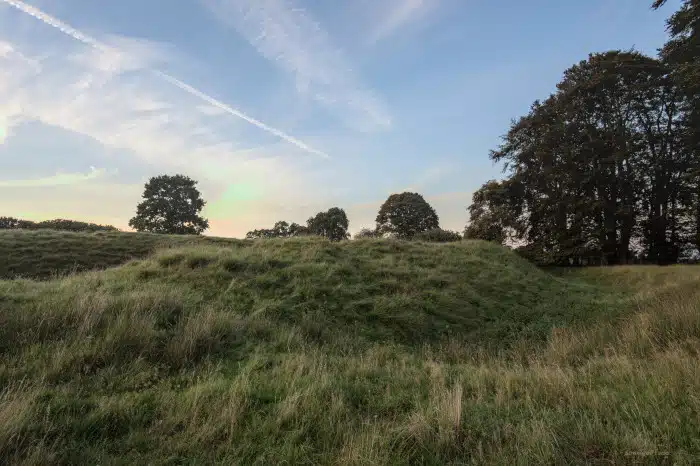
If you want to visit the ramparts of Magelund Woldsted today, you can hike there through a stately beech forest by the Hyldan Bro (bridge) into the Gammelbæk valley. As the entire area, including the valley meadows, is grazed, there are, as so often in Denmark, pasture fences that can be passed through field gates on the hiking trails. The wet meadows are certainly also interesting from an ornithological point of view.
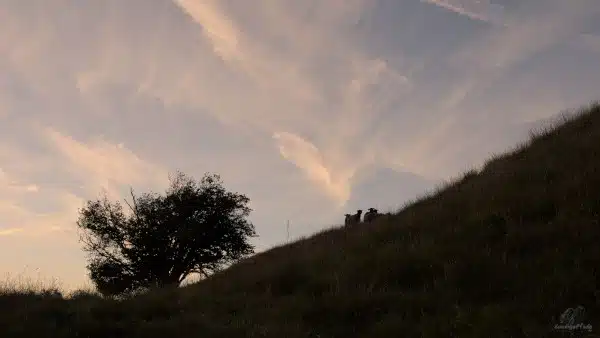
Lykkesholm Slot and Gammelmølle
In the Ørbæk å valley there are several hiking trails that can be followed on foot or by bike. Including Magelundvej (the small road), circular walks are also possible. The valley itself is mostly wooded, and there are small ponds along Ørbæk å – Gammelmølle Sø to the east of Lykkesholm Slot and Kobbermose to the west of the manor.
Gammelmølle Sø is the mill pond for the mill of the same name, whose present buildings date from 1890. Further east, there was another watermill, Nymølle, which used the water power of the Ørbæk å. However, Nymølle was completely dismantled in 1949, including the half-timbered house and ancillary facilities, and moved to an open-air museum near Copenhagen. Today, only the remains of the foundation walls can be found. The mill pond is silted up and wooded.

Lykkesholm manor is situated on a four-sided rampart and is privately owned. It is therefore not open to the public. The Danish poet Hans Christian Andersen stayed at Lykkesholm several times, as he considered the castle to be the most beautiful place on the whole of Funen island. He drew inspiration for several of his works here: „Only a Minstrel“, „The 12 Months of the Year“, „The Rosebud“
The surroundings are beautiful throughout the valley. Greylag geese regularly breed on the Kobbermose. As this is an extended peat cut, botanical rarities can also be expected on the banks.
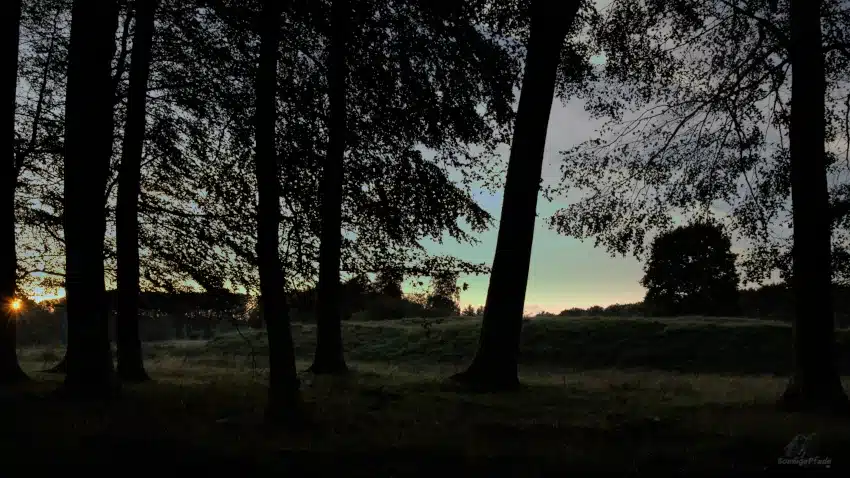
[Contains *advertising]
Travel tips for the historical sites of Lindeskov (Funen island)
How to get there
The next major airport in Denmark is Kopenhagen airport. There you can get the full service with train or bus connections or rent-a-car service*.
If you are traveling by car on Funen island, you can easily find your way to the larger crossroads town of Ørbæk southwest of Nyborg. From there it is only a few kilometers on Assensvej to Lindeskov, where Magelundvej branches off to Lykkesholm. If you don’t like the narrow winding road through the Ørbæk å valley (e.g. with a motorhome), you can also drive from Ellested to the manor via Lykkeholmvej.
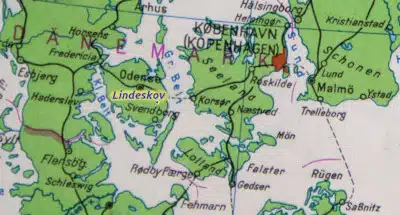
If you are touring Funen island by bike, the Lindeskov dolmens are on the cycle route 51 Faaborg – Nyborg. For example, I was in nearby Ekeskov Slot and cycled from there via Lindeskov to Ladby to the Viking Museum near Kerteminde – all by bike, which was very nice on mostly narrow roads through a varied landscape.
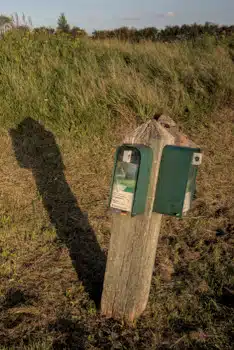
If you cycle directly to the Lindeskov dolmen (the 168m long dolmen) first, you will find an information sheet in a flyer dispenser, also in English, with a small map of the region, a list of all the archaeological monuments, the castle and the mills and brief archaeological and natural history descriptions. This makes it much easier to find your way on the other routes. (Publisher: Nyborg Kommune)
The weather
My weather recommendation for a visit to Lindeskov: At sunrise or sunset on a clear day with „fleecy clouds“, the dolmens are particularly beautiful when the stone settings cast long shadows over the hills. Or the mystical alternative on a cloudy, misty day, when you can barely see from one side of the burial mounds to the other….
To help you plan your history excursion to the Stone Age, you will find a brief overview of the weather in Lindeskov region today and over the next days.
° Image source: wikimedia.org, faithful photographic reproduction of the painting by F.M.E. Fabritius de Tengnagel (1781-1849)
More adventures at the baltic sea islands in Denmark
Get to know the history of the Ladby Dragon – in the Lady Viking museum
Visit the neolithic burial mound of Mårhøj – enter the grave chamber with your own torch
Discover the diversity of Langeland with manor, wind mill and nature reserve



